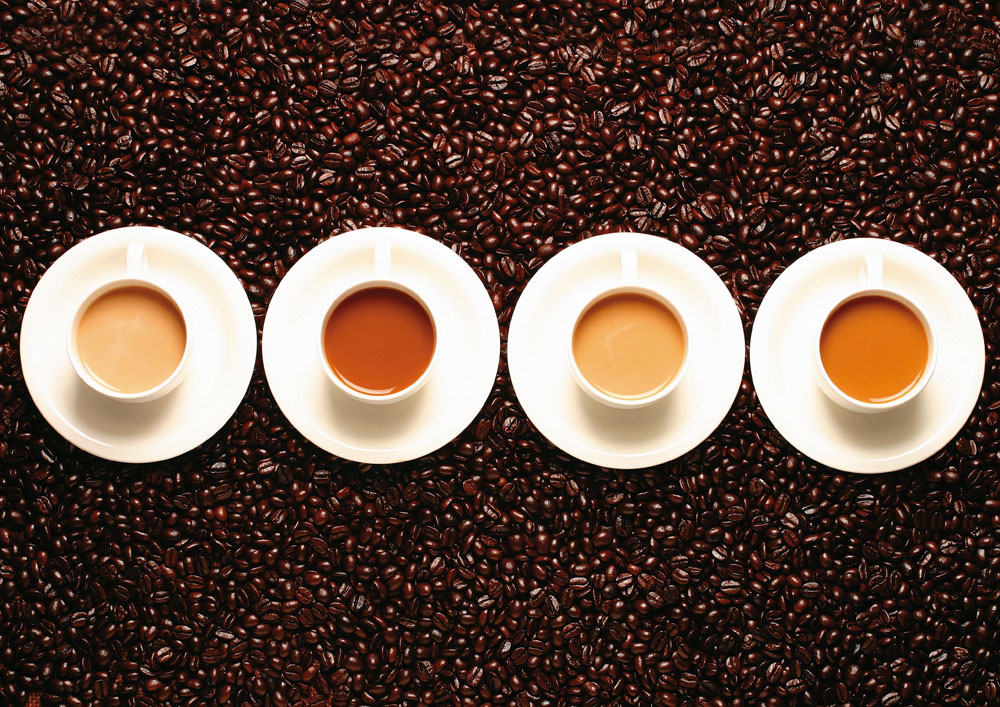Technical rules for cultivation of small seed Coffee basic knowledge of Coffee

1 scope this part stipulates the technical methods of small seed coffee garden selection, planning, reclamation, seeds, seedlings, planting, soil management and coffee tree management.
This part is suitable for the cultivation of small seed coffee. 2 normative citation documents the provisions of the following documents become the provisions of this part through the citation of this section. All subsequent corrections (excluding corrigendum) or revisions of dated citation documents do not apply to this section, however, parties agreed in accordance with this standard are encouraged to study whether the latest versions of these documents can be used. The latest version of any undated reference file applies to this section.
GB/T 18007 Murray 1999 Coffee and its products
Rules for the inspection of crop seeds in GB/T 3543Mui 1995
GB 4284mur1984 Control Standard for pollutants in Agricultural sludge
GB 4285mur1989 Standard for safe use of pesticides
GB 8172 color 1987 agricultural control standard for urban garbage
GB/T 8321 guidelines for rational use of pesticides
NY 5023mur2002 Environmental conditions for producing Tropical fruits as pollution-free Food
NY/T 358mur1999 Coffee Seeds
NY/T 359mur1999 coffee seedlings
NY/T 393mur2000 guidelines for the use of pesticides in green food
NY/T 394Mur2000 guidelines for the use of Green Food Fertilizer 3. 1. Climatic conditions: annual average temperature 18 ℃ ~ 23 ℃, ≥ 10 ℃ annual active accumulated temperature ≥ 6800 ℃, minimum monthly average temperature ≥ 11.5 ℃, extreme minimum temperature > 0 ℃, basically frost-free; annual average precipitation 1000 ~ 1800, annual average relative humidity > 70%, dryness < 1.5 If the precipitation is less than 1000 tons, the land with water source irrigation should be selected in the arid areas of flowering and young fruit stage. The average annual wind speed is less than 1.5m/S in a quiet wind environment. 3.2Geomorphological conditions should be low mountains, hills and gentle platforms above sea level 700m~1300m, but not lowlands, low platforms, cold lakes, narrow valleys, gullies and hail zones with poor discharge of cold air and easy deposition. In winter, sunny slopes, semi-sunny slopes and semi-shady slopes can be selected in areas with higher air temperature (monthly average temperature > 13 ℃, extreme minimum temperature > 1 ℃); sunny slopes should be selected in areas with lower temperature (monthly mean temperature < 13 ℃, extreme lowest temperature < 1 ℃); leeward slopes should be selected in areas dominated by strong advection, with slopes below 25 degrees; middle and upper slopes should be selected in radiation low temperature areas; and lower slopes should be selected in advection low temperature areas. 3.3 soil conditions should be lateritic red soil and latosol; PH 5.5-6.5; soil layer thickness more than 0.8 m, groundwater level below 1 m, good drainage; loose and fertile soil, loam or sandy loam, organic matter content more than 1%. 3.4 Environmental conditions the environmental conditions of the garden should comply with the provisions of NY 5023 on the environmental conditions of tropical fruit producing areas of pollution-free food. 4 Garden Planning 4.1 Road Planning 4.1.1 Garden Trunk Road
The main road from the peeling factory (field) to the residential area and coffee garden, the roadbed width is generally 3m~4m, the road surface width is 3m, the longitudinal slope is less than 8%, and the bend radius is more than 15m.
4.1.2 Garden sidewalk
According to the management position and irrigation needs, the walking road in the garden is set up according to local conditions, and the "Zhi" road is set up between the hills and slopes, and the road width is about 1m. 4.2 drainage and irrigation system planning DB53/T 154.2mur2006 4.2.1 layout of drainage and irrigation canal system in garden land bucket canals are generally arranged along smaller watersheds or contours, agricultural canals are generally perpendicular to contours or contour terraces, and hairy canals are direct irrigation channels in the garden, with the same distance as the terrace belt, and are arranged along the planting belt; drainage ditches are arranged along the hillside concave.
4.2.2 types of garden irrigation
Gentle slopes, platforms, ditches and ditches for irrigation with abundant water sources; drip irrigation systems for those with insufficient water sources; in areas where water sources are scarce or unstable, a number of water cellars and fertilizer ponds should be built in the appropriate locations in the garden for spraying fertilizer and spraying water. 4.3 Shelterbelt Planning 4.3.1 in ridges, peaks, gullies, tuyeres and other areas and areas with strong winds, shelterbelts should be retained or built, and shelterbelt networks must be set up in severe storm hazard areas.
4.3.2 soil and water conservation forests should be set up in areas with serious soil erosion. Water source forests should be strictly protected and felling and reclamation are prohibited.
4.3.3 Tree species with strong adaptability, fast growth and non-host of coffee diseases and insect pests should be selected for shelterbelt.
4.4 processing plants and residential planning 4.4.1 processing plants
It should be determined according to environmental conditions and production management needs. In the construction of continuous coffee gardens, the processing plant and base management center (field department) should be built in the center of the garden as far as possible, and coffee gardens of more than 500 mu should consider building processing plants, pools, sun farms, warehouses, and equipped with electric fruit peeling machines and means of transportation.
4.4.2 settlement
According to the needs of garden management, residential areas should be built separately and centrally, and each point should be built in the center of the garden as far as possible. 5 Garden Reclamation 5.1 after the end of the rainy season to February of the following year, clear the tall grass and shrub in the garden in order to open ditches and build platforms. The shelterbelt and water source forest were preserved, and the scattered independent trees with fast growth, strong resistance, wide adaptability and non-coffee diseases and insect pests were selected as shade trees. 5.2 Construction of horizontal terraces below 5 degrees gentle garden shall be calibrated by "cross", and equal high terraces shall be built on slopes above 5 degrees, with a width of 1.8m~2.0m and an inner inclination of 3-5 degrees. 5.3 time and specification for digging planting ditches and leaving topsoil 5.3.1
The mouth of the planting groove is 60 inches wide, 50 inches deep and 40 inches wide at the bottom. The trenching operation should be completed before the rainy season.
5.3.2 return to topsoil and base fertilizer
Generally, each plant was fertilized with farm manure of 5 to 10 years, P2O518~36g. Before the rainy season, mix organic fertilizer, phosphate fertilizer and topsoil well into the planting ditch. After backfilling, the ditch surface should be more than 15 inches higher than the table.
DB53/T 154.2 Mel 2006 5.4 planting density 5.4.1 reasonable close planting according to variety characteristics and geomorphological conditions.
5.4.2 on flat land or gentle slope below 5 degrees, the general row spacing is 0.8 × 2m, and 416 plants are planted per mu. 5.4.3 on the slope of 25 degrees, the general distance between plants is 0.81m, and there are 333 plants per mu. 5.4.4 the hilltop and Liangzi lots should be properly closely planted. 6 planting 6.1 seed 6.1.1 seed quality index
6.1.1.1 the degree of typical consistency in characteristics and characteristics of variety purity varieties is expressed by the percentage of the number of seeds of this variety in the number of seeds of the varieties to be tested.
6.1.1.2 the percentage of the number of normal seedlings grown within the specified conditions and time in the number of seeds tested.
6.1.1.3 seed moisture content the weight lost by drying the seed sample according to the prescribed procedure is expressed as a percentage of the original weight of the sample to be tested.
6.1.1.4 the percentage of seeds with intact seeds in the number of varieties to be tested.
6.1.1.5 seed plumpness, the plumpness of seeds was expressed by the percentage of completely sunken seeds after soaking in water at the initial temperature of 45 ℃ for 18 hours.
6.1.1.6 the number of days during which seeds are preserved by conventional methods.
The seed quality index should meet the requirements of the following table: table 1 Coffee seed quality index
Important Notice :
前街咖啡 FrontStreet Coffee has moved to new addredd:
FrontStreet Coffee Address: 315,Donghua East Road,GuangZhou
Tel:020 38364473
- Prev

Basic definition of Arabica coffee fresh fruit Rain concept Basic knowledge of coffee
1 Scope This part specifies the terms and definitions of Arabica coffee fresh fruit, fruit picking requirements, fresh fruit classification, packaging, transportation and temporary storage. This part applies to Pu 'er Arabica coffee. 2 Normative references The provisions of the following documents become the provisions of this part by reference to this part. All subsequent amendments (excluding corrigenda) to a dated reference
- Next

Yerga Coffee is actually a small town.
Yegasherfi is a small town with an altitude of 1700- 2100 meters. It is also synonymous with Ethiopian fine beans. This is a wetland since ancient times. The old saying "yirga" means "settle down","cheffe" means "wetland", so "yirga cheffe" means "let us settle down in this wetland". It is one of Ethiopia's highest coffee producing areas on average. Yegassie
Related
- Detailed explanation of Jadeite planting Land in Panamanian Jadeite Manor introduction to the grading system of Jadeite competitive bidding, Red bid, Green bid and Rose Summer
- Story of Coffee planting in Brenka region of Costa Rica Stonehenge Manor anaerobic heavy honey treatment of flavor mouth
- What's on the barrel of Blue Mountain Coffee beans?
- Can American coffee also pull flowers? How to use hot American style to pull out a good-looking pattern?
- Can you make a cold extract with coffee beans? What is the right proportion for cold-extracted coffee formula?
- Indonesian PWN Gold Mandrine Coffee Origin Features Flavor How to Chong? Mandolin coffee is American.
- A brief introduction to the flavor characteristics of Brazilian yellow bourbon coffee beans
- What is the effect of different water quality on the flavor of cold-extracted coffee? What kind of water is best for brewing coffee?
- Why do you think of Rose Summer whenever you mention Panamanian coffee?
- Introduction to the characteristics of authentic blue mountain coffee bean producing areas? What is the CIB Coffee Authority in Jamaica?

